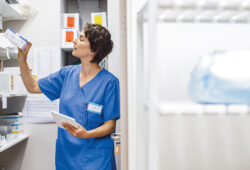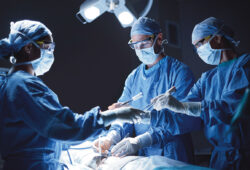Getting stuck with a needle never feels good. But an accidental prick with a used needle or a cut from a scalpel can be especially harmful, even deadly. The Needlestick Safety and Prevention Act of 2000 made needle safety a priority in hospitals, but clinicians still need to be alert to the dangers and institute tougher safety protocols to prevent blood-borne illnesses. Supply chain professionals are part of the solution, too, and can back clinical teams by introducing reliable safety technology that healthcare providers will like and use.
“Patient safety is a No. 1 priority of HealthTrust when we choose contracts,” says Angie Mitchell, RN, former director of nursing services, “and our portfolio continues to grow.” Experts from MYCO Medical and Cardinal Health—two in a long line of suppliers included in HealthTrust’s vast patient safety portfolio—outlined some ways for facilities to up their game when it comes to sharps safety.
Multi-faceted Risks
Most healthcare professionals know that if they come into direct contact with a sharps device—defined by the Food and Drug Administration as a device with sharp points or edges that can puncture or cut skin—they could potentially be exposed to HIV, hepatitis and many other blood-borne pathogens, infections and diseases. The Centers for Disease Control and Prevention (CDC) estimates that every day, more than 1,000 healthcare workers in the hospital setting are injured with a needle or other sharps device. Of the injuries reported, most involve nurses, but accidents also happen to laboratory staff, physicians and housekeepers. The risks are considerable: According to the CDC, healthcare workers’ chances of infection from a contaminated sharps injury are 1 in 5 for hepatitis B (if they’re not vaccinated), 1 in 50 for hepatitis C and 1 in 300 for HIV.
Stay on Sharps Alert
According to the Centers for Disease Control and Prevention, examples of high-risk situations using sharps include:
During patient care:
– Inserting or withdrawing a needle
– Inserting needles into IV lines
– Handling or passing sharps
Immediately after sharps use:
– Recapping a used needle
– Transferring or processing specimens
During and after sharps disposal:
– Disposing of sharps into proper containers
– Cleaning up after a procedure
– Sharps left on floors and tables, or found in linens, beds or waste containers
In hospitals, 80 percent of sharps injuries are due to the use of:
– Hypodermic needles/syringes
– Suture needles
– Winged-steel (butterfly-type) needles
– Blood collection needles
– Scalpels
– IV stylets
Many other devices, including ones made of glass, can also cause sharps injuries.
The dangers come from use and improper disposal of sharps devices. (See sidebar for the CDC’s list of common high-risk situations when it comes to sharps use.) “A caregiver could receive an inadvertent needle stick during or following a procedure; an EVS employee could come in contact with an inappropriately disposed injection device; or a visiting family member could even be injured by a carelessly discarded sharps device,” says Tom Harkin, global vice president of marketing for general medical products at Cardinal Health.
And as the use of heroin, fentanyl and other illegal drugs rises at an epidemic level, people taking used needles from hospitals (along with sharps disposal containers) and reusing them is a growing concern, Harkin adds. “In addition to the obvious adverse impact on society, this intentional act of diversion can create security issues with unauthorized individuals—whether patients, family members or even hospital staff without clearance—seeking access to needles throughout the hospital. It’s essential that facilities invest in products with appropriate safety measures to decrease the risk.”
Playing It Safe
To avoid the risks related to sharps injuries, hospitals are encouraged to develop a bloodborne pathogen exposure control plan, says Sharon A. McNamara, RN, past president of AORN (Association of periOperative Registered Nurses) and a MYCO Medical advisory board member. “Research has demonstrated that a risk reduction program that incorporates sharps safety devices and safe work practices with proper education and training can help prevent percutaneous injuries,” she says.
That plan should include the adoption of a nonpunitive reporting system to encourage incident reports. “Standard practice today when someone is stuck by a needle is the completion of an incident report submitted to a hospital’s risk management department,” Mitchell explains. “The perception when someone completes this report is that he or she has ‘done something wrong’ even if the incident was unavoidable. As a result, these incidents are often not reported. A culture change is needed to try to eliminate the feeling of guilt or fear that people think you were at fault.”
Medical equipment manufacturers now offer tools and equipment with extra safety controls, but some healthcare professionals resist change, McNamara admits. A health system is more likely to adopt sharps safety devices if the professionals who will use the devices have an opportunity to evaluate and select the ones that best meet their needs. That’s where the experts on HealthTrust clinical advisory boards come in, adding the member voice to the GPO process for evaluating how certain devices might affect patient and worker safety.

Taking Advantage of Technology
Safety technology generally falls into one of two categories: passive or active. Passive safety devices don’t require worker action for the safety feature to function. Examples include needles shielded or recessed in protective housing, hypodermic needles that automatically retract into the syringe after the injection is given, and needleless connectors for IV lines. Active devices, such as hypodermic needles for injections, needleless devices to access an IV port or blunt suture needles, require the user to initiate the safety feature.
Among the important considerations are whether devices can be activated with one hand, and if they provide an audible or visual indication that the safety feature has been activated, according to Sam Kumar, president and CEO of MYCO Medical. Device features should also be easily understood, reliable and simple to use, and the safety elements should not be able to be removed or interfere with patient care.
Safe disposal containers are also required. “Facilities should look for products that utilize counterbalanced lids, which allow used sharps to drop horizontally into the container with no need to assist or push,” Harkin says. “The lid should be designed to ensure that used sharps drop away from the user as they enter the container. Additionally, the lid should restrict hand access into the container and automatically close when full to eliminate the potential of overfilling.”
Facilities that promote a culture of safety have fewer sharps injuries, according to the CDC. The characteristics of such a hospital include a shared commitment by management and staff to sharps injury prevention and leadership that encourages the prompt reporting of sharps injuries without punishment.
For more information, go to cdc.gov/sharpssafety.






